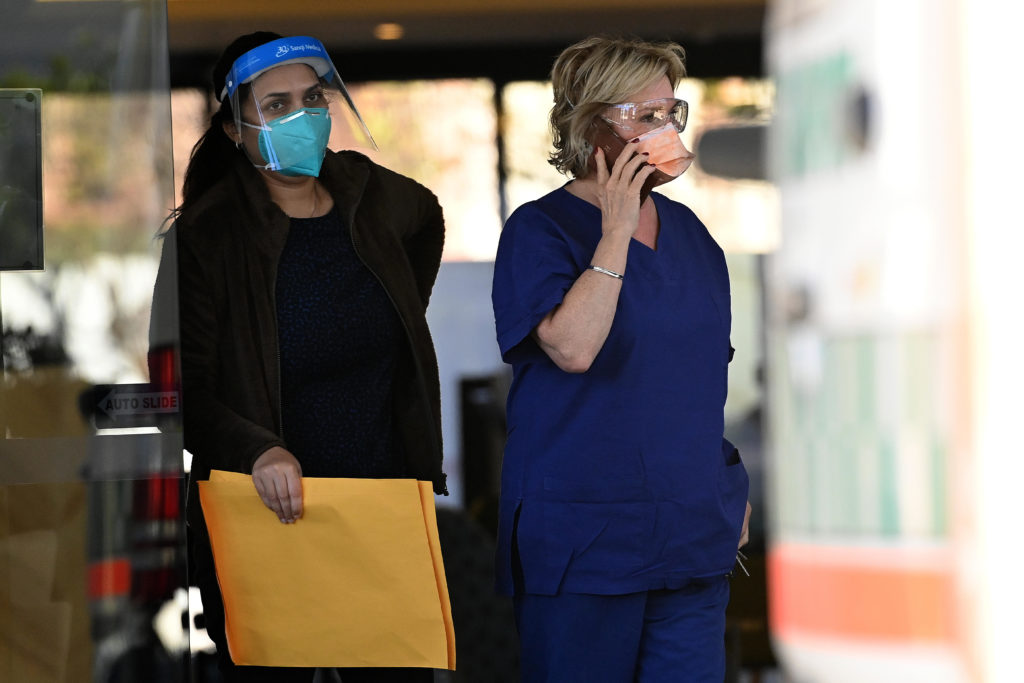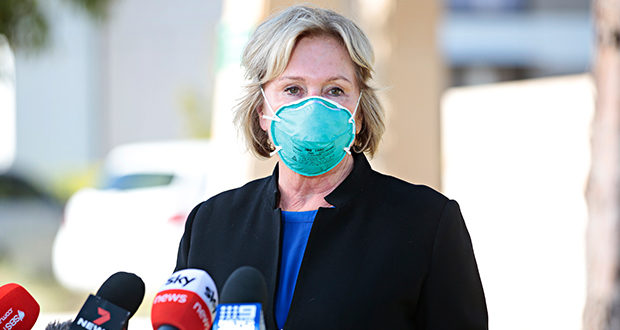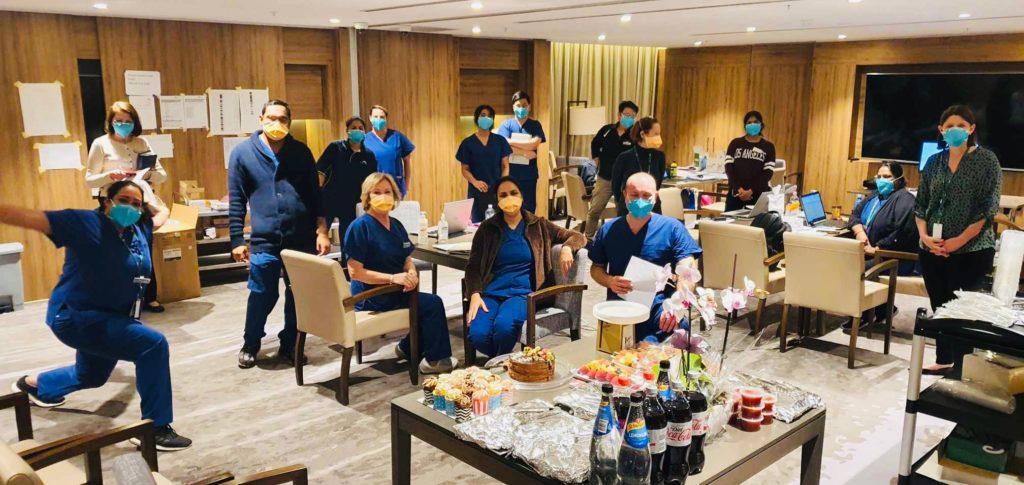It was one o'clock in the morning when Michelle Sloane got the call.
She got out of bed, drove to Baulkham Hills in Sydney’s west, and by 3.00am she was informing families that a COVID-19 outbreak had spread inside their loved ones' home.
“My heart dropped,” says Michelle as she remembers the call.
Michelle was the chief executive of SummitCare at the time, a company with 10 homes across greater Sydney.
“Something you never want to hear as a CEO is that you've got a positive COVID test in your home.”
After witnessing the devastation the virus wrought on the country's residential aged care homes, including in Melbourne where over 600 lives were lost, providers around the country began scrambling to prepare for the worst.
Michelle says that prior to this year's outbreak, SummitCare had revised multiple outbreak planning scenarios, and felt prepared when the Delta variant began its spread through NSW.
But within a week of that 1.00am call, 11 people in Baulkham Hills, including five workers and six residents, were infected with the virus.
“In the early stages, it felt a bit like a war zone,” says Michelle, who seems calm when remembering those early days, yet slightly shaken from the experience.
In the early hours of that first morning, all the infected residents were transferred to Westmead Hospital and over 80 per cent of the facility's staff were sent into isolation.
For every staff member lost, two more workers were needed to fill the gaps.
“I believe we were very well prepared,” says Michelle.
“We had a very strong pandemic outbreak plan, and we had a very strong communications plan.
“One thing we did realise is you can plan as much as you want, but when you're in the middle of an outbreak, it's very different to what you've planned.”
Prior to the outbreak, Michelle and her team had performed emergency scenarios, stocked up on PPE, organised webinars, and had undergone infection control processes.
Still, she hadn't anticipated the onsite kitchen would need to be closed and that mass amounts of food would need to be ferried in to feed the residents and staff.
In the thick of it, she says, it was the small details that caught her off guard.
“There's unexpected things you come across in that first outbreak – the loss of staff, the quantity of contaminated waste.
“Then the other surprises of not being able to cook onsite and not being able to shower residents.”
I told him, look, I'm a registered nurse and you married one, and you should be aware that it's part of my job
After hearing news of the outbreak, 25-year-old registered nurse Shumayl Gulzar was asked if she would transfer to Baulkham Hills from her SummitCare home in Smithfield.
“It was very intimidating going in and I calmed myself down, saying, 'you are a registered nurse and it's your responsibility, and if you want to do it, you want to do it',” she told Aged Care Insite.
“So, I walked in, and I'm glad I did.”
When she told her husband that she would be on the frontlines of an active outbreak, he feared for her safety.
“I told him, look, I'm a registered nurse and you married one and you should be aware that it's part of my job.”
Shuymal’s nerves calmed the moment she walked onto the premises. She was greeted by a large infection control team, an army of supplies, a large table of PPE, and a team of RNs and care workers, just like herself, ready to get to work.
During the first 72 hours, the team worked tirelessly into the early hours of the morning. Shumayl says the staff had to remind each other to eat and rest, and each person took turns to go upstairs to have a break when they could.
Around 149 residents had been confined to their rooms and were under the team's care, none of whom the young nurse had met before. Remembering her training, Shumayl began to highlight the highest priority residents in red, second in yellow, and third in blue.
Some of the residents were confused and anxious about the new strangers dressed in large, blue surgical gowns and facemasks.
“You take baby steps with them, you tell them we have to do this to make sure you are safe, and we are safe,” says Shumayl.
“We used nonverbal communication with people that didn’t have the capability to understand.”
Residents would sit in their doorways and play corridor bingo, and staff organised one-on-one craft and leisure activities, and visits from physiotherapists.
The team, including the RNs, pharmacy staff and kitchen workers, all remained in constant communication with each other.
“Everyone played a role,” says Shumayl.
“I was there in the mornings. I had someone to cover me some days, like at seven or eight PM and that person would stay until night.”
It was around three days later when news of the outbreak hit the media, and photographers and reporters began to gather outside.
Worried families soon began inundating the home with calls to check on their loved ones.
“Managing COVID itself is stressful enough, then reassuring families that their loved ones are okay, then making sure that they're actually okay, and on top of that, we have the tension building up from the media,” says Shumayl.
“And every time you would see news, it would just be like, 'oh my god, are they going to say something good?'.”
By this stage, Michelle was speaking with Westmead hospital twice a day to check in on the hospitalised residents. In between taking phone calls from families and checking in on staff, she was also told she was responsible for addressing the large media presence outside.
Dressed in blue scrubs, goggles and a facemask, she walked outside to face the cameras.
“I was naturally a little nervous,” said Michelle.
“I told them exactly what was happening, there was no point in trying to hide anything.”

The media glare was intense. Soon the daughter of two of the infected residents began to speak out publicly and the media camped out front of the home for the next 10 days.
Michelle also had to contend with images in the media that appeared to show distressed residents pressing their hands and faces up against the windows of the home. According to Michelle, the women in the photograph were living in the dementia unit and were simply curious about the commotion occurring outside.
“At first, [the residents] were all scared,” she said. “They were seeing it on television, they were hearing it from the TV before we were able to get to them.
“We were very conscious of keeping them informed, the communiqués I was sending out to the families twice a day were also being delivered to the residents on their meal trays.”
For the first two weeks of the outbreak, Michelle lived onsite with about 50 of her staff on an unused upper floor of the home. It was tough as her partner was stuck in Melbourne at the time and had to support her from afar. But her two adult daughters took turns to visit and bring her clothes, toiletries and food.
Before the cooked meals began coming in from other SummitCare homes, the exhausted team lived off potato chips, and chocolate.
“You were caught in this kind of vortex for about a month,” said Michelle.
“We just kept focusing on the end game, frankly.”
A nurse through and through, Michelle wasn't worried about catching the virus herself and as her team, with the help of NSW health, got on top of the outbreak, she felt confident in the high level of infection control they had implemented.
Speaking with Michelle in October, with the Baulkham Hills outbreak under control, she says that the last few months have been a blur.
As it stands, around one hundred per cent of SummitCare’s residents and staff have now received both jabs, she says.
“I think that everyone would agree in aged care that perhaps it could have been done differently.”
“Every year aged care providers administer their own Fluvax, usually in conjunction with their GPs and/or their own immunisers.
“If the government had allowed this to happen with the covid jabs, then all residents and staff at each home could have received their jabs in a more cost-effective and efficient manner.”
The outbreak started in July and would last 30 days, and all of the staff and residents who tested positive have recovered.
But fears of another outbreak soon followed as a fully vaccinated nurse at the SummitCare facility in St Mary's tested positive.
An infected doctor would also enter the organisation’s Penrith home causing panic in early September.
While no other residents have tested positive, the threat of the virus has become routine for the staff, residents and families of SummitCare.
“The subsequent outbreaks have been more manageable because the team of course is now far more experienced than they were in July,” says Michelle.
“We're very conscious of each other and the fact that everyone is tired. Therefore I think everyone's trying to be very, very sympathetic with one another.”
Residents, no longer quarantined in their rooms, can move freely around their designated zones and are preparing for in-person visits next week as 'freedom day' approaches.
“Clearly they are missing their families,” says Michelle.
“We've tried to be, and continue to be, as innovative as we can in keeping them entertained and making sure that their spirits are uplifted.
“The team are very tight, and they've got tighter as the months have gone on. “
After four years with the organisation, Michelle was recently appointed chief executive officer and co-director of Summit Healthcare.
The last three months have been testing and she admits that trying to switch off in her downtime is difficult. Watching Netflix, or reading with a glass of wine in the evening helps, as does early morning walks with her dog. But her work is always front of mind.
“I think that the entire age care industry is running on adrenaline right now,” she says.
“Until we can get vaccinations to the level we need them in the community, and hopefully the case numbers right down, I think everyone will feel the same way.
“I hope by Christmas we’ll be there.”
Do you have an idea for a story?Email [email protected]
 Aged Care Insite Australia's number one aged care news source
Aged Care Insite Australia's number one aged care news source


